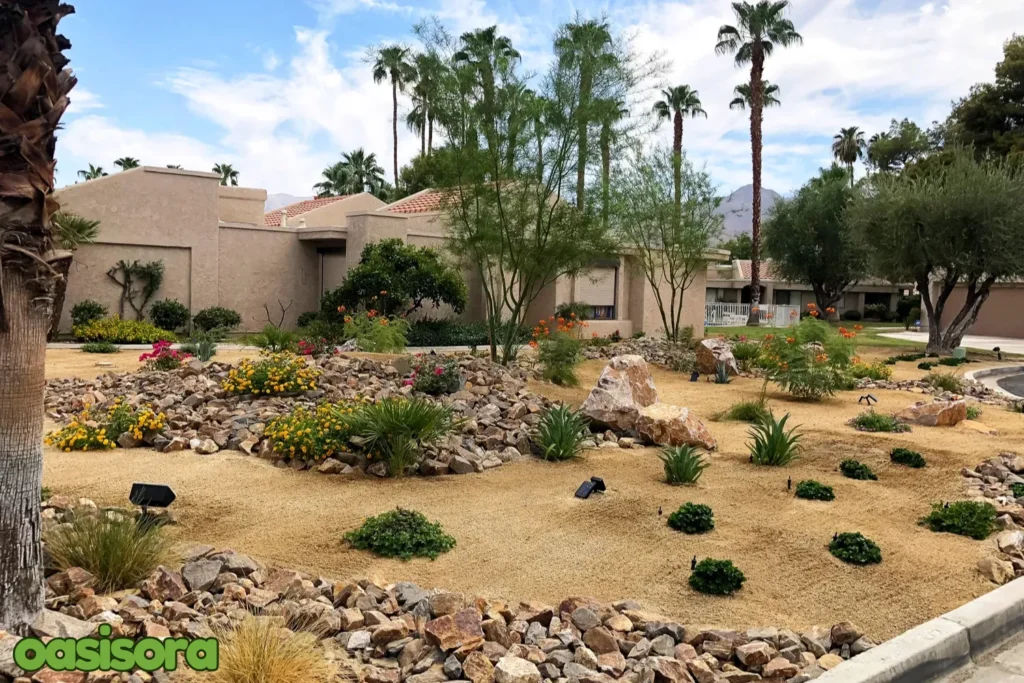
Are you sick of spending your weekends pulling weeds and mowing your lawn? You’re not alone then! Many of us face this…but fret not! Decomposed granite is the solution!!.
Many people like me want to spend time with our family and friends instead of caring for our lawns. That’s why we all need a yard that’s too effortless to take care for. And here, Decomposed granite can help.
It’s a great way to create a remarkable outdoor oasis that’s perfect for entertaining and also enhances the look of your house without putting in a lot of effort. And the best part? It’s easy to do yourself!.
Let’s learn how to make a beautiful yard by landscaping with decomposed granite!.
What is Decomposed Granite (DG)?
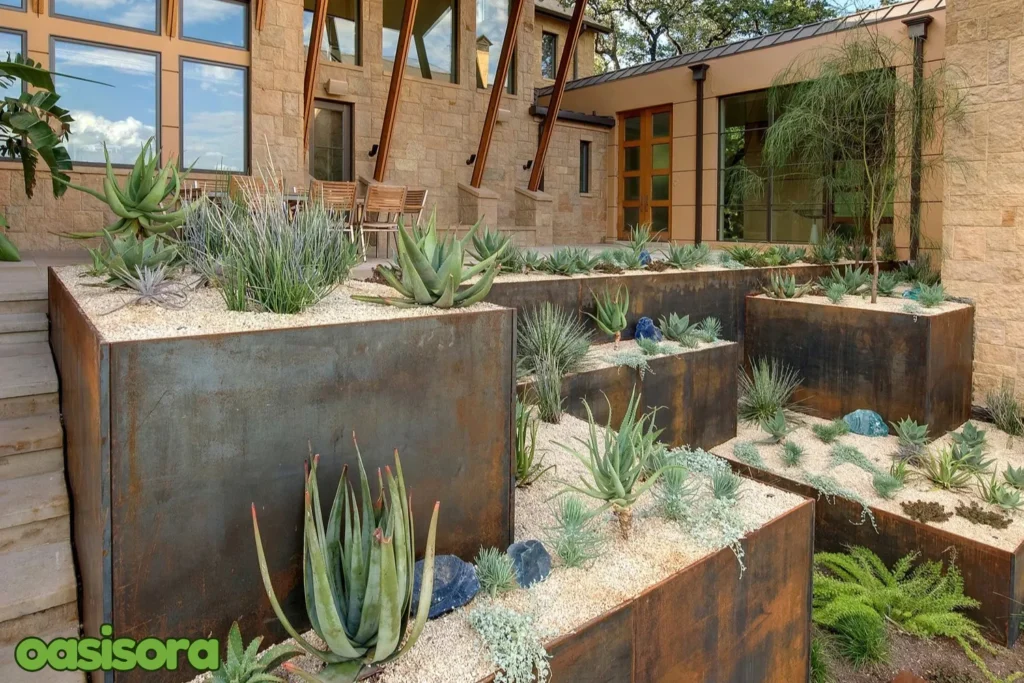
Smaller pieces Gravel-sized particles (grus)
Decomposed granite is a sort of weathered granite rock that splits down into:
- Smaller, weaker pieces
- Gravel-sized particles (grus)
- Mixtures of clay, silica sand, and silt particles
Formation of DG
Granite rocks get broken down into tiny pieces over time. This happens because of wind, water, and temperature changes. A new material is produced as a result of this that is rich in nutrients and minerals and resembles fine gravel.
Popularity for Landscaping:
Landscaping with decomposed granite is an excellent selection. It is longer-lasting, natural, and reasonably priced. Also, water drains through it efficiently and has an attractive, vintage appearance.
It works well in places where a lot of people walk and stroll. For patios, walkways, and other outdoors, this is ideal. The best aspect is that it’s too simple to install.
Why Choose Decomposed Granite for Your Landscaping?
The following are key practical and amazing perks of using decomposed granite for landscaping:
Looks Great
Decomposed granite looks effortlessly pretty in your outdoor areas. It comes in various colors such as gold, gray, and pink. Plus, you can pick your favorite hue that fits with your yard to make it pretty.
Saves Money
Decomposed granite is cheaper than concrete or stone. It makes your yard look nice without costing too much.
Easy to Use
The best thing about Decomposed granite is its ease of use. You don’t need special tools. Just spread it around, press it down, and rake it sometimes to make it look great.
Good for the Earth
Decomposed granite is good for the Earth since it is natural. It helps the water go into the ground and doesn’t hurt the planet. If you are a green person, go for it!
Many Uses
You can use decomposed granite for:
- Driveways
- Walkways
- Gardens
It’s great for areas you walk or drive on. It’s also good for new gardeners.
Helps with Water Drainage
Decomposed granite helps with water drainage. It lets water go into the ground. This is good because it stops water from pooling. Pooling water can be bad. It can hurt plants and make a mess. DG helps stop this from happening.
Popular Colors and Types of Decomposed Granite
Here are some popular kinds of decomposed granite that can be used for various landscaping purposes:
Desert Gold
This sort of decomposed granite is a prevalent choice due to Its warm, golden color that adds elegance to your garden or outdoor areas. It’s great for southwestern-themed designs.
Plus, looks more beautiful with green plants and colorful flowers. And my folks!. The contrast of it is stunning. If you desire to add some warmth and style to your yard. It’s remarkable for you!.
California Gold
This California Gold decomposed granite, one of the best gravel options for fire pit seating areas, is too aesthetic and beautiful. It has a light golden color that looks like it’s been kissed by the sun. Ha-ha… I mean sun-kissed!.
It gives our yard a cozy and inviting atmosphere plus makes our outside areas appear cheery and bright. Plus, it lends a sense of elegance to patios, walks, and gardens and is great for Mediterranean and California-style settings.
Graphite Gray
One of the most versatile and modern choices is graphite grey. Its dark gray hue gives outdoor areas a sleek, elegant background. Graphite gray is fantastic for modern landscapes because it contrasts beautifully with architectural elements, flowers, and vegetation.
Apache Brown
Apache Brown is a warm, earthy shade of granite. Its rich brown color can add depth and character to your outdoor space. Plus, Apache Brown creates a beautiful harmony with native plants, rocks, and wooden features ideal for rustic and natural-looking landscapes.
Indian Red
This striking reddish-brown granite adds comfort to any outdoor retreat. Beautiful flowers, rich greenery, and architectural features all contrast well with Indian red.
Palm Springs Gold
This kind of decomposed granite is beautiful. It’s light golden. It visualizes the sunny landscapes of Palm Springs. It’s flawless for making a modern, chic, and Mediterranean-style outdoor oasis.
It adds a touch of elegance. It’s also great for California-style landscapes. It makes them look fancy and sophisticated.
Southwest Brown
The color of this decomposed granite is warm and earthy brown. It makes us think of the Southwest in America. Plus, it looks wonderful for outdoor places with a rustic or natural style. It’s also ideal for landscapes with a desert vibe.
Differences Between DG and Other Landscape Rocks
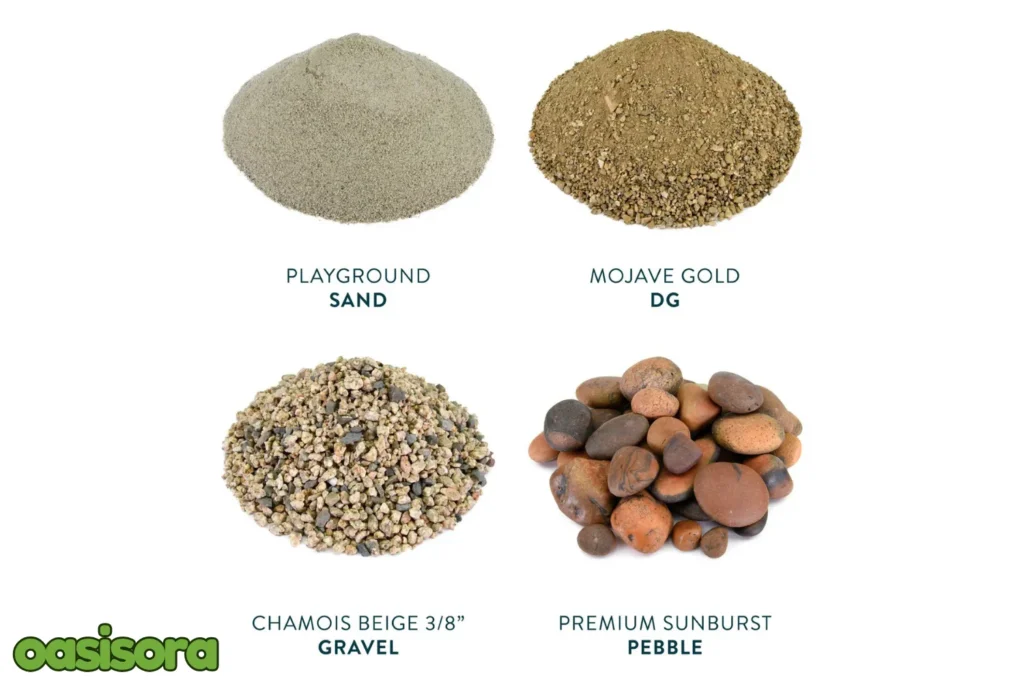
Decomposed Granite & Other Landscape rocks
Selecting the appropriate landscaping material is essential. We must understand the difference between other rocks and decomposed granite. Let’s examine:
Smoothness
Decomposed granite is smooth and nice to walk on. But, gravel is rough. It can hurt your feet. Whereas, the crushed stone can cut you as it is sharp.
Placement
The (DG) decomposed granite doesn’t move around and it stays in place. However, gravel and crushed stone do move and can wash away or shift.
Appearance
Gravel and crushed stone can look fake. They can stand out too much. But, decomposed granite looks natural and it fits in with the outdoor environment.
Also, it comes in dissimilar colors and looks pretty and easy to use. It’s great for making your outdoor spaces look lovely.
Top Landscaping Projects Using Decomposed Granite
Decomposed granite, or DG, is an eminent material for landscaping projects. It’s easy to work with, looks great, and is good for the environment. Here are a few of the most prevalent applications for landscaping with decomposed granite in your yard:
Patios and Courtyards
Want a pretty patio or courtyard? For this, use decomposed granite! It comes in a variety of hues and is incredibly soft underfoot.
In a xeriscaped garden, decomposed granite can also be used in the same way as sand or gravel. It can therefore be used to create a lovely seating area or a play area for children.
Walkways and Pathways
Because it is easy to walk on and doesn’t become sticky when wet, decomposed granite is perfect for sidewalks and pathways. Plus, you can make a pleasant path to your front door or through your garden using this remarkable material.
DG is made up of tiny particles. This means it can work on slopes if mixed with soil stabilizers that keep it in place. You can even buy DG with these helpers already mixed in.
If you want to make this project, have a look at this blog post, What You’ll Want for Decomposed Granite Pathway.
Driveways
You can also use decomposed granite for your driveways. It’s cheap and lasts a long time and Water drains well through it. Some people like the sound it makes when you walk on it.
DG comes in many colors, so you can pick one that matches your house. You can choose normal colors like gray or white, or bright colors like brimstone.
Flower Beds and Mulch
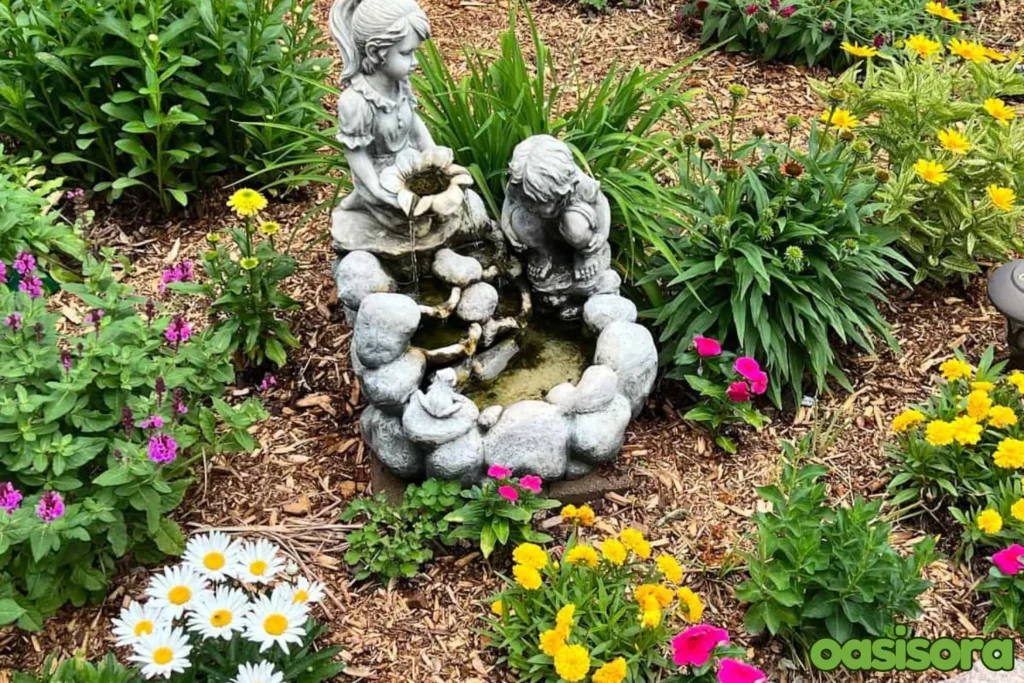
Flower beds and Mulch
People usually think of mulch as wood chips or sawdust, but DG works very well too. It lasts longer than wood mulch because it doesn’t break down. It can last many seasons, making it a good choice. Hence, you can say that it’s a wise investment for your yard.
Play Areas or Sports Surfaces
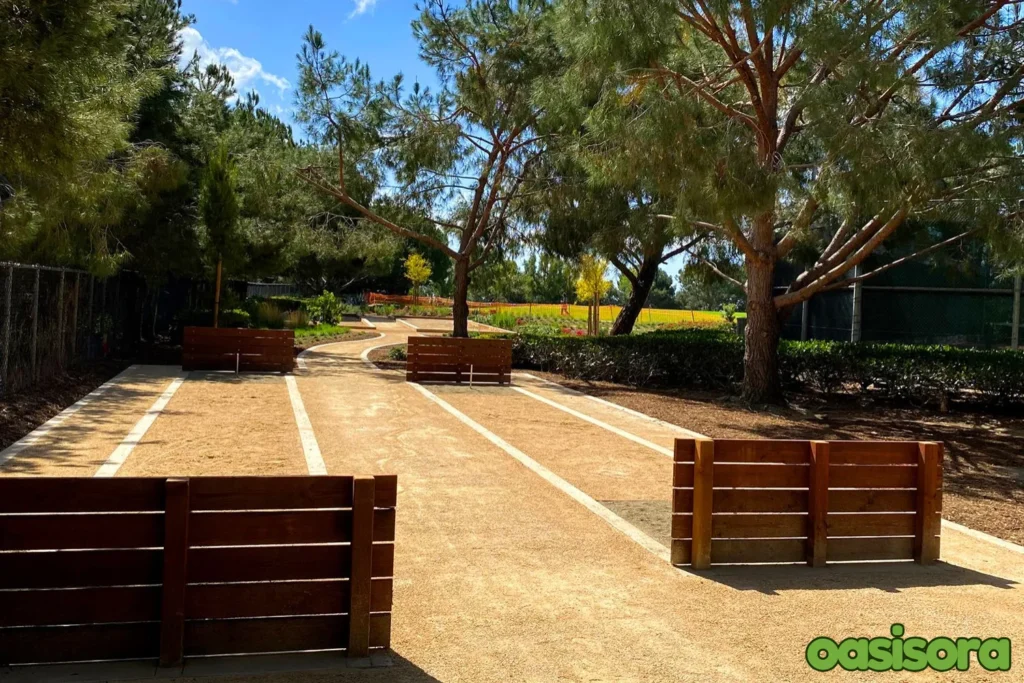
Sports Area with Decomposed Granite
Do you want a fun and safe play area in your backyard?. Then, consider doing landscaping with decomposed granite! It’s perfect for outdoor games and activities. DG is even used on baseball fields and running tracks because it’s strong and lasts long.
For play areas, it’s often mixed with clay to make it smoother. You can even use it for bocce ball courts! We have special mixes for bocce courts that look nice and work well. For all the bocce fans out there, check out this post.
How to Build a Bocce Ball Court. We have special Bocce Blends that make your court look great and work well. And guess what? A bocce court is also perfect for playing horseshoes!
Fire Pit Areas
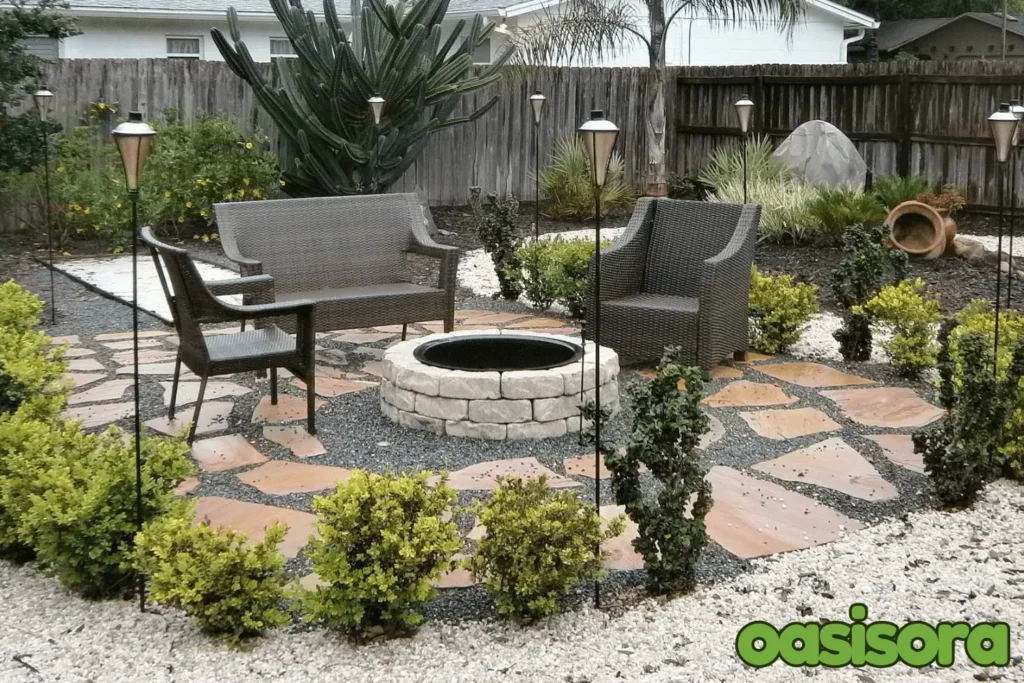
Fire Pit Area with Granite
It’s very simple and enjoyable to create a fire pit area!. An excellent material to utilize around your fire pit is decomposed granite. Because it doesn’t catch fire easily, it helps maintain the region safe.
Plus, it looks nice and is easy to clean up. You can make a nice seating area around the fire pit using DG, and it’s comfortable to walk on too.
Water Features and Garden Trails
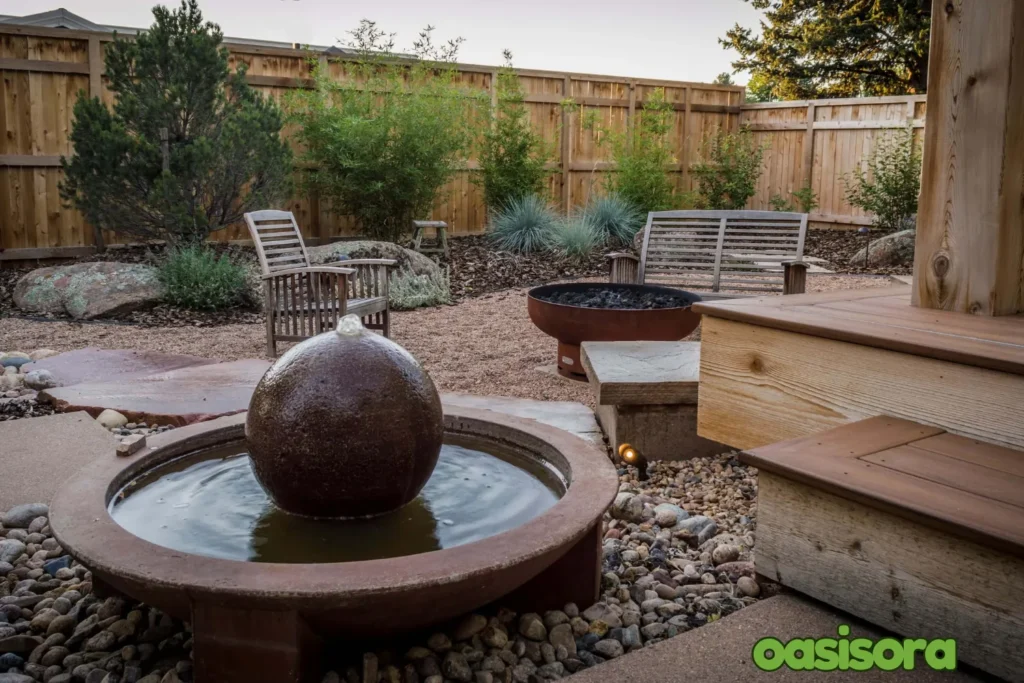
Water features and garden trails
The landscaping with decomposed granite is flawless for water features and garden trails. It’s easy to walk on and looks great around ponds, fountains, and streams.
For garden trails, DG helps keep the path clear and prevents weeds from growing. Plus, it comes in different colors to match your garden’s style!
Choosing the Right Type of Decomposed Granite for Your Project
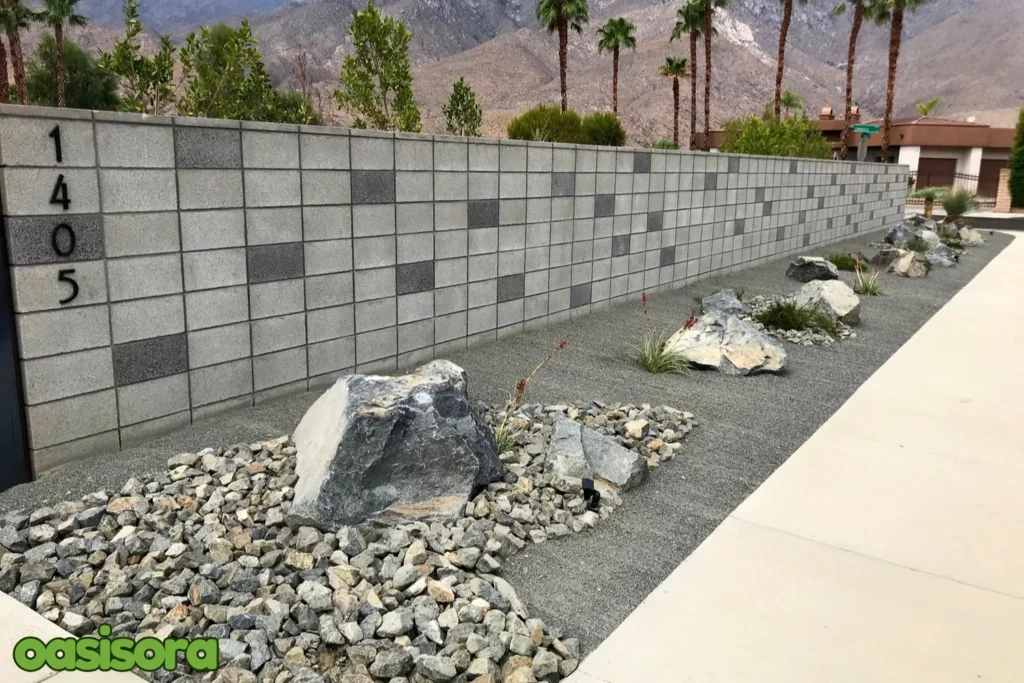
Decomposed Granite Stabilizer
Decomposed granite is a mix of small stones, coarse sand, and tiny dusty particles. Some types have more tiny particles, called “fines”. To make decomposed granite last longer, you can add a special helper called a soil stabilizer like Marloc-SS. Stabilizer.
This keeps the DG in place, making a strong surface for patios and paths. It also helps stop weeds, dust, and erosion. To learn more about the stabilizer, read this post, “What is Stabilized DG?”.
Here’s a breakdown of the diverse types of DG and how to do the best landscaping with decomposed granite.
Natural Decomposed Granite
- Unstabilized and uncompacted
- Prone to erosion and settling
- Requires regular maintenance
- Inexpensive option
Stabilized Decomposed Granite
- Mixed with a stabilizer to hold particles together
- More durable and resistant to erosion
- Can withstand heavy foot traffic
- Available with different stabilizers, such as organic or polymer-based options
Resin-Bound Decomposed Granite
- Mixed with a resin binder to create a solid surface
- Highly durable and resistant to erosion
- Can withstand heavy vehicular traffic
- More expensive than stabilized DG
Now for landscaping with decomposed granite, let’s discuss how to choose the best type of DG for your project:
Consider the Intended Use
If the area will experience heavy foot or vehicular traffic, stabilized or resin-bound DG may be the better choice.
Think about maintenance:
If you don’t want to deal with regular maintenance, stabilized or resin-bound DG may be the better choice.
Look at your budget:
Natural DG is the most inexpensive option, while resin-bound DG is the most expensive.
Consider the appearance:
It comes in various colors and textures. Choose the one that well- fits your project’s aesthetic.
Stabilized Decomposed Granite: Pros and Cons
It’s a type of DG that has been mixed with a stabilizer to increase its durability and resistance to erosion. Here are some pros and cons of stabilized DG:
Pros:
Longer Lasting
Resists erosion and withstands heavy traffic
Less Maintenance
Requires less upkeep than unstabilized DG.
Safer Surface
Provides a stable surface, reducing tripping hazards
Heavy-Duty
Can support heavier loads, perfect for high-traffic areas
Cons:
Higher Cost
Stabilized DG is more expensive than unstabilized DG
Less Flexibility
Hard to make changes or repairs once it’s installed
Environmental Concerns
Some stabilizers can harm the environment by contaminating soil or water.
Appearance
Stabilized DG may look slightly different than unstabilized DG, which might not be what you want for your project.
When to Use Stabilized DG:
Landscaping with decomposed granite that is stabilized can be done in such areas:
- High-traffic areas
Stabilized DG performs best in areas with high foot or vehicle traffic.
- Erosion Areas
It can help stop erosion in areas with a lot of rainfall or runoff.
- Commercial projects
Moreover, this DG is often used in commercial projects, including shopping centers, office parks, or restaurants.
Design Tips for Landscaping with Decomposed Granite
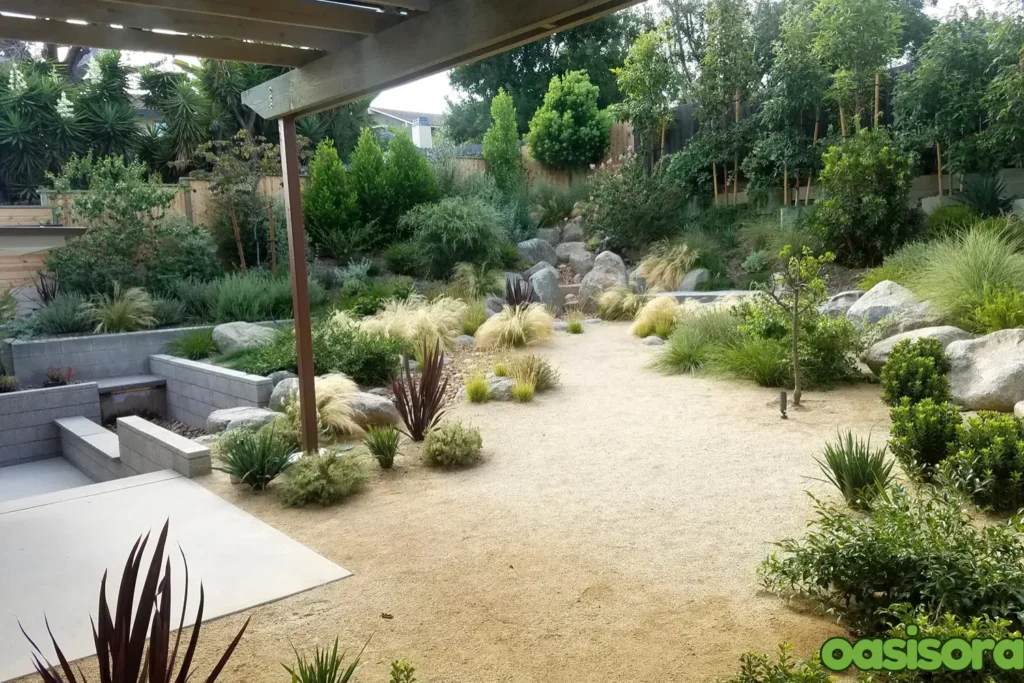
Landscape Design with Decomposed Granite
Folks! Now read some exciting tips if you are willing to do landscaping your yard with decomposed granite:
Planning and Design Considerations
For designing consider these tips:
Color Coordination:
Select a DG color that blends in with the exterior of your house, the plants that surround it, and the hardscaping.
Blending with Other Elements:
To create an eye-catching setting, mix DG with other materials like wood, stones, or pavers.
Use of Space for Function:
Think about the space’s intended usage, such as areas for play, leisure, or outdoor eating.
Blending with Natural Elements
Reading this will help you blend your favorite plants into your landscape:
Native Plants:
To create a smooth transition between your DG landscape and the surrounding area, include native trees, shrubs, and plants.
Rock and Boulders:
Utilize boulders and other naturally occurring rock formations to give your DG landscape texture and visual appeal.
Water elements:
To create a calm and organic atmosphere, include water elements like fountains or tiny ponds.
How to Create a Natural Flow Using DG
For the creation of natural flow in your yard, follow these tips:
Gradual Transitions:
To create a natural flow, use slow transitions between your landscape’s various sections.
Curved Lines:
To replicate the organic curves of the surroundings, use curved lines and shapes.
Layering:
Arrange DG, stones, and plants among other objects to create depth and visual interest.
- Choosing Edging for Decomposed Granite Areas
Here’s how you can pick edging for DG areas:
Metal Edging:
You can use metal edging to create a clean, modern look and to prevent DG from spreading.
Plastic Edging:
Choose plastic edging for a more affordable and easy-to-install option.
Natural Stone Edging:
Incorporate natural stone edging to create a seamless transition between your DG landscape and surrounding hardscaping material.
How to Install Decomposed Granite?
Landscaping with decomposed granite can be a straightforward process, especially for simple projects like mulch or flower bed bases. However, for more complex projects, follow these steps:
Design and Layout
After choosing where to put your DG, measure and mark the area with stakes and paint.
Perimeter Edging
Create a border around your DG area using bender boards, wood, or steel edging, and secure it with stakes.
Excavation and Compaction
Dig out 4” of soil inside the border and pack it down firmly using a hand tamper or a vibrating plate.
Adding a Rock Subbase (For Pathways or Driveways)
Add 2” of DG or crushed rock to the area and pack it down tightly with a hand tamper.
Landscape Fabric Installation
Landscaping with decomposed granite requires fabric too!! Lay down a weed barrier over the packed base and secure it with landscape staples.
Filling the Area with DG
Fill the remaining 2″ space with granite and rake it out consistently. If needed, add a soil stabilizer. Compact the area again. Need help? Contact your nearest Southwest Boulder & Granite Store for guidance!
Compacting the DG Layer
You can use a hand tamper or plate compactor to pack the DG tightly.
Tools and Materials Needed for DG Installation
Here is the list of key tools you need for the creation of landscaping with decomposed granite:
Tools:
- Spade shovel
- Hand tamper
- Plate compactor (optional)
- Rake
- Wheelbarrow or bucket
- Landscape fabric staples
- Hammer or mallet
Materials:
- Decomposed granite (DG)
- Weed barrier fabric
- Landscape edging (bender boards, wood, or steel)
- Soil stabilizer (Marloc-SS or other)
- Construction paint
- Stakes
Maintenance Tips for Decomposed Granite Landscaping
My friends! Now let’s read some tips if you have decided to do landscaping with decomposed granite:
Regular Raking:
Rake DG regularly to maintain its even texture and prevent weeds.
Weed Control:
Remove weeds promptly to prevent root growth.
Watering:
Water DG lightly, avoiding over-saturation.
Replenish DG:
Replenish DG as needed to maintain its depth.
Edge Maintenance:
Inspect and repair edging as needed.
Soil Stabilizer:
Reapply soil stabilizer periodically to maintain DG’s stability.
Conclusion
Landscaping with decomposed granite is an excellent choice. It’s a dream come true for those who want super low-maintenance, eco-friendly, and stunningly beautiful landscape material.
Plus, It is also durable, drains water very well, and is ideal for your patios, walkways or driveways, and even play areas. You can follow our simple guide and tips above to create a breathtaking outdoor space for you that can boost your home’s value and become your serene oasis to chill out.
Whether you’re a DIY enthusiast or a pro, decomposed granite landscaping makes your outdoor dreams a reality.
What are you waiting for?. Go ahead and start planning your DG project today and get ready to enjoy a beautiful, functional, and sustainable outdoor space for years to come!
FAQs
How does drainage affect decomposed granite?
Drainage benefits greatly from decomposed granite. It causes no puddles as water passes through it.
What is the lifespan of decomposed granite?
Granite that has decomposed lasts for ten years or longer. Just install and care for it properly.
Can I make my driveway from landscaping with decomposed granite?
Yes, of course you can! Just pack it down tight and think about how much traffic it’ll get.
Does decomposed granite get muddy when wet?
Yes, it can get a bit muddy, however it will be good and not get so muddy if you install it the right way.
Is decomposed granite ecologically beneficial?
Yes, it is natural and beneficial to the environment, and it also aids in water drainage.

1 thought on “A Guide to Landscaping with Decomposed Granite in 2025”
Comments are closed.